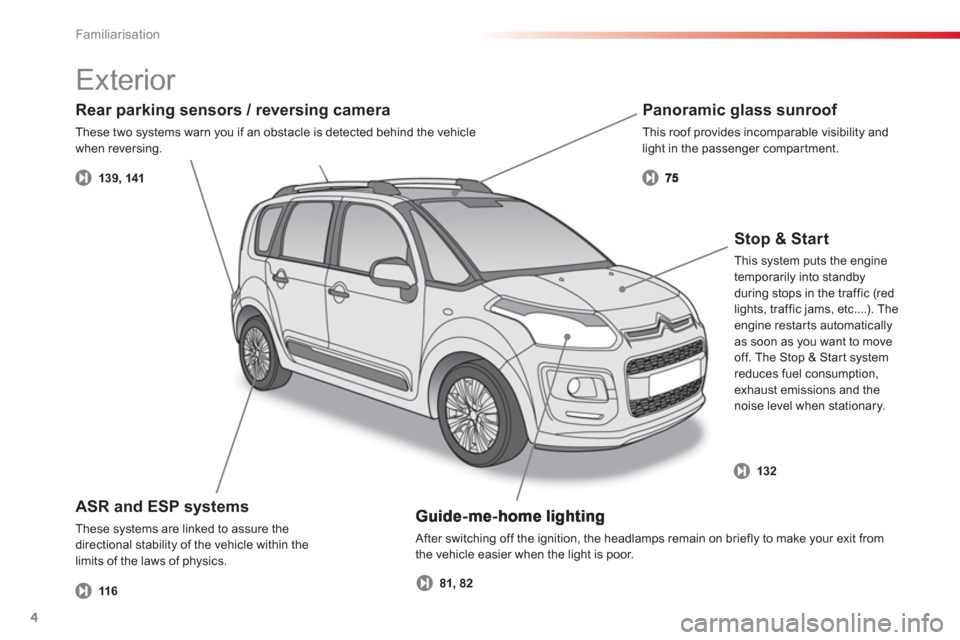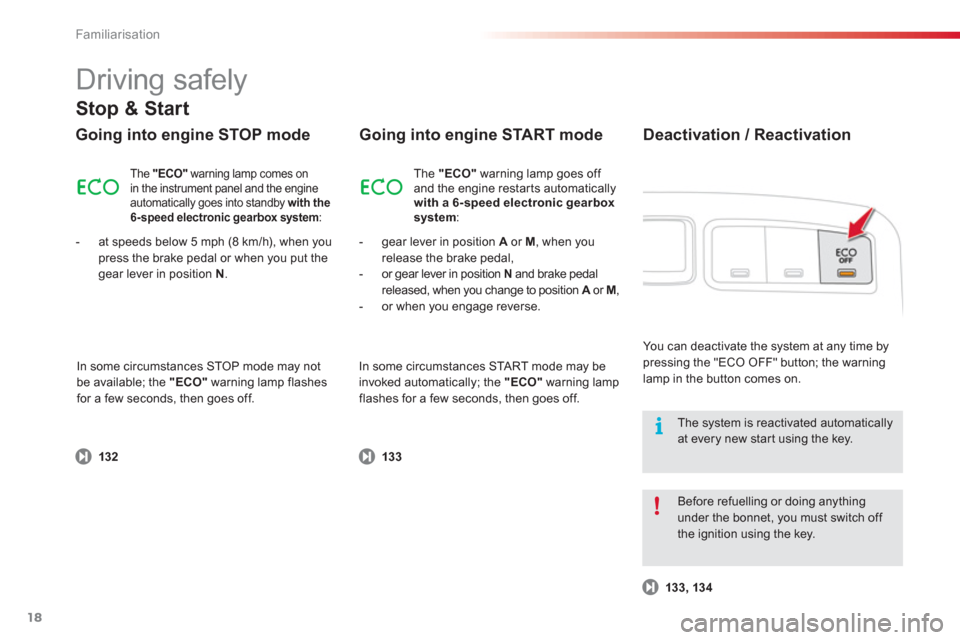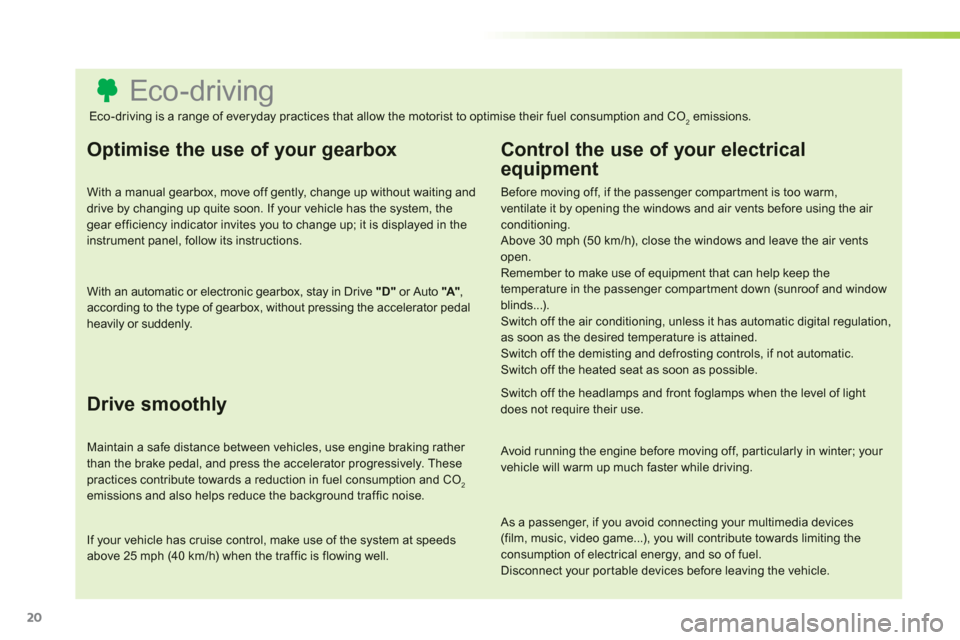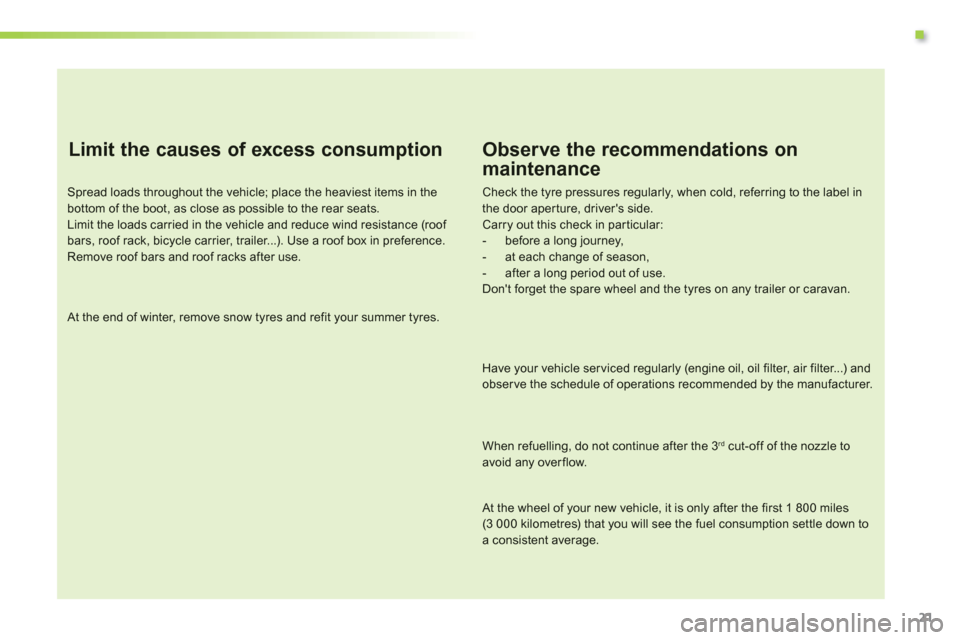engine Citroen C3 PICASSO RHD 2013 1.G Owner's Manual
[x] Cancel search | Manufacturer: CITROEN, Model Year: 2013, Model line: C3 PICASSO RHD, Model: Citroen C3 PICASSO RHD 2013 1.GPages: 284, PDF Size: 8.84 MB
Page 5 of 284

.
Contents
Direction indicators 113
Hazard warning lamps 113
Horn 113
Emergency or assistance call 114
Brakin
g assistance systems 114
Tr a
jectory control systems 116
Front seat belts 117
Airbags 121
Safety
Parking brake 125
6-speed manual gearbox 125
Gear effi ciency indicator 126
6-speed electronic gearbox system 127
Hill start assist 131
Stop & Start 132
Speed limiter 135
Cruise control 137
Rear parking sensors 139
Reversing camera 141
Driving
Emergency or assistance 199
eMyWay 201
Audio system 255
Audio and telematics
Alphabetical index
Bonnet 143
Running out of fuel (Diesel) 144
Petrol engines 145
Diesel engines 146
Checking levels 147
Checks 149
Checks
Te m p o r a ry puncture repair kit 151
Changing a wheel 156
Changing a bulb 163
Changing a fuse 172
Battery 179
Energy economy mode 181
Changing a wiper blade 182
To w i ng the vehicle 183
To w i ng a trailer 185
Fitting roof bars 186
Accessories 187
Snow chains 189
Practical informationTechnical data
Petrol engines 190
Petrol weights 191
LPG engines 192
LPG weights 193
Diesel engines 194
Diesel wei
ghts 195
Dimensions 196
Identifi cation markings 197
Page 6 of 284

Familiarisation
4
After switching off the ignition, the headlamps remain on briefly to make your exit from
the vehicle easier when the light is poor.
ASR and ESP systems
These systems are linked to assure the
directional stability o
f the vehicle within the
limits of the laws of physics.
Panoramic glass sunroof
This roof provides incomparable visibility and light in the passenger compartment.
Rear parking sensors / reversing camera
These two systems warn you if an obstacle is detected behind the vehicle
when reversing.
11
6
Stop & Start
This system puts the engine
temporarily into standby
during stops in the traffic (red lights, traffic jams, etc....). The
engine restar ts automatically as soon as you want to move
off. The Stop & Start systemreduces fuel consumption, exhaust emissions and thenoise level when stationary.
Exterior
139, 141
81, 82
132
Page 17 of 284

.Familiarisation
15
Tr a n s l u c e n t d igital
instrument panel
Switch panels
If the levels are not correct, top up the levels
which are low.A.With the ignition on, the level of fuelremaining is displayed in the digitalinstrument panel.B.With the ignition on, the oil level indicator should display "OIL OK"for a few seconds. Illumination of the indicator lamp indicates the
status of the corresponding function.A.Deactivation of the ESP/ASR system. With the i
gnition on, the orange and red
warning lamps come on.
With the engine running, these warning lampsshould go off almost immediately, with theexception of warning lamp C
(passenger'sfront airbag activated) which goes off after
approximately one minute.
If warning lamps remain on, refer to the
relevant page.
Warning lamps
Monitoring
222311
6
140
72
133
B. Deactivation of the rear parking sensors.
C.
Central locking.
D.Deactivation of the Stop & Start system.
Page 19 of 284

.Familiarisation
17
Driving safely
This 6 -speed gearbox offers the choice of the comfor t of automated operation or the pleasure
of manual gear changing.
1.Gear lever.2."-"
steering mounted control paddle. 3."+"steering mounted control paddle.
The
gear engaged or the driving mode selected appears in the instrument panel screen. N.Neutral. R. Reverse.1 to 6.
Gears engaged. AUTO.
Automated mode.
�)
Select position N
and press the brake pedal firmly while star ting the engine.�)
Select automated mode (position A
) or Amanual mode (position M ) by moving thegear lever 1,
or
en
gage reverse by pushing the gear lever 1towards position R . �) Release the parking brake.�)
Progressively release the foot brake, then
accelerate away.
6-speed electronic
gearbox system
Display in the instrument panel
Moving off
127
Page 20 of 284

Familiarisation
18
Driving safely
Going into engine STOP mode
- gear lever in position A
or M, when you
release the brake pedal,
- or
gear lever in position N
and brake pedal
released, when you change to position Aor AM,
- or when you engage reverse.
Stop & Start
The "ECO"
warning lamp comes on
in the instrument panel and the engine
automatically goes into standby with the
6-speed electronic gearbox syste
m:
- at speeds below 5 mph (8 km/h), when you
press the brake pedal or when you put thegear lever in position N .
Going into engine START mode
The "ECO"
warning lamp goes off
and the engine restarts automatically
with a 6-speed electronic gearbox
syste
m:
In some circumstances
STOP mode may not
be available; the "ECO"
warning lamp flashesfor a few seconds, then goes off. In some circumstances
STA R T m o d e m ay be
invoked automatically; the "ECO"warning lamp flashes for a few seconds, then goes off.
Deactivation / Reactivation
You can deactivate the system at any time by
pressing the "ECO OFF" button; the warninglamp in the button comes on.
Before refuelling or doing anything under the bonnet, you must switch off
the ignition using the key.
The system is reactivated automatically at every new start using the key.
13
2133
133, 13 4
Page 22 of 284

20
Eco-driving
Optimise the use of your gearbox
With a manual gearbox, move off gently, change up without waiting and drive by changing up quite soon. If your vehicle has the system, the gear efficiency indicator invites you to change up; it is displayed in theinstrument panel, follow its instructions.
With an automatic or electronic gearbox, stay in Drive "D"or Auto "A"
, according to the type of gearbox, without pressing the accelerator pedalheavily or suddenly.
Drive smoothly
Maintain a safe distance between vehicles, use engine braking rather than the brake pedal, and press the accelerator progressively. Thesepractices contribute towards a reduction in fuel consumption and CO2emissions and also helps reduce the background traffic noise.
If your vehicle has cruise control, make use of the system at speedsabove 25 mph (40 km/h) when the traffic is flowing well.
Control the use of your electrical
equipment
Before moving off, if the passenger compar tment is too warm, ventilate it by opening the windows and air vents before using the air conditioning.
Above 30 mph (50 km/h), close the windows and leave the air ventsopen.
Remember to make use of equipment that can help keep the temperature in the passenger compar tment down (sunroof and windowblinds...).
Switch off the air conditioning, unless it has automatic digital regulation,as soon as the desired temperature is attained. Switch off the demisting and defrosting controls, if not automatic. Switch off the heated seat as soon as possible.
Switch off the headlamps and front foglamps when the level of lightdoes not require their use.
Avoid running the engine before moving off, particularly in winter; your vehicle will warm up much faster while driving.
As a passenger, if you avoid connecting your multimedia devices
(film, music, video game...), you will contribute towards limiting theconsumption of electrical energy, and so of fuel.
Disconnect your por table devices before leaving the vehicle.
Eco-driving is a range of everyday practices that allow the motorist to optimise their fuel consumption and CO2emissions.
Page 23 of 284

.
21
Limit the causes of excess consumption
Spread loads throughout the vehicle; place the heaviest items in the bottom of the boot, as close as possible to the rear seats.Limit the loads carried in the vehicle and reduce wind resistance (roof bars, roof rack, bicycle carrier, trailer...). Use a roof box in preference.Remove roof bars and roof racks after use.
At the end of winter, remove snow tyres and refit your summer tyres.
Observe the recommendations on
maintenance
Check the tyre pressures regularly, when cold, referring to the label inthe door aperture, driver's side. Carry out this check in par ticular:
- before a long journey,
- at each change of season,
- after a long period out of use.
Don't forget the spare wheel and the tyres on any trailer or caravan.
Have your vehicle ser viced regularly (engine oil, oil filter, air filter...) andobser ve the schedule of operations recommended by the manufacturer.
When refuelling, do not continue after the 3 rd
cut-off of the nozzle toavoid any overflow.
At the wheel of your new vehicle, it is only after the first 1 800 miles (3 000 kilometres) that you will see the fuel consumption settle down toa consistent average.
Page 24 of 284

Monitoring
22
Petrol - Diesel instrument panel
Panel grouping together the digital indicator, the multifunction screen and the vehicle operation
indicator lamps.
1.Rev counter.Indicates the speed of rotation of the
engine (x 1000 rpm). 2. Rev counter zone indicating that you must change up a gear. 3.Speed limiteror
Cruise control.(mph or km/h)
4.Electric child lock indicator lamp.Indicates, for a few seconds, the activation
of the electric child lock (deactivation of the rear windows and doors).
Tr a n s l u c e n t d igital instrument panel
This screen groups together the warning and
information messages.
Multifunction screen
Indicator lamps display zone
This zone groups together the vehicle operation indicator lamps.
Display zero reset button
This permits resetting of the function selected
to zero (trip distance recorder or ser vice
indicator).
Instrument panel lighting button
This adjusts the brightness of the lighting of theinstruments and controls. 5
.Fuel level. Indicates the quantity of fuel remaining in
the tank.
6.Vehicle speed. Indicates the current speed of the moving
vehicle (mph or km/h).
7.Trip distance recorder. (miles or km) 8. Ser vice indicator.
(miles or km) then, Distance recorder. (miles or km) 9.Engine oil level indicator.
For more information, refer to the paragraph relating to the button or function and its associated display.
Page 25 of 284

1
Monitoring
23
Indicator and warning lamps
Visual indicators informing the driver that a system is in operation (operation or deactivation indicator lamps) or of the occurrence of a fault (warning
lamp).
Associated warnings
The illumination of certain warning lamps may
be accompanied by an audible signal and amessage in the multifunction screen.
The warning lamps may come on continuously (fixed) or flash.
When the ignition is switched on
Certain warning lamps come on for a few seconds
when the vehicle's ignition is switched on.
When the engine is started, these same
warning lamps should go off.
If they remain on, before moving off, refer to the
information on the warning lamp concerned.
Certain warning lamps may come onin one of two different modes. Only by relating the type of illumination to the operating status of the vehicle can itbe ascertained whether the situation isnormal or whether a fault has occurred.
Operation indicator lamps
If one of the following indicator lamps comes on, this confirms that the corresponding system has come into operation.
Warning lampis onCauseAction / Observations
Left-hand directionindicator
flashing with buzzer.The lighting stalk is pushed down.
Right-handdirection indicatorr
flashing with buzzer. The lighting stalk is pushed up.
Sidelamps
fixed. The lighting stalk is in the
"Sidelamps" position.
Dipped beamheadlamps fixed. The lighting stalk is in the "Dipped beam headlamps" position.
Main beam headlamps fixed. The lighting stalk is pulled towardsyou. Pull the stalk to return to dipped beam headlamps.
Page 26 of 284

Monitoring
24
Warning lampis onCauseAction / Observations
Front foglampsfixed.The front foglamps are switched on. Turn the ring on the stalk rear wards twice to switch off
the front foglamps.
Rear foglampsfixed.The rear foglamps are switched on. Turn the ring on the stalk rear wards to switch off the
rear foglamps.
Diesel engine pre-heatingfixed.The ignition switch is at the
2nd position (ignition on).Wait until the warning lamp has switched off before starting.
The duration for which the warning lamp is on is determined
by the climatic conditions.
Parking brakefixed.The parking brake is applied or not properly released.Release the parking brake to switch off the warninglamp, keeping your foot on the brake pedal.
Obser ve the safety recommendations.
For further information on the parking brake, refer to
the "Parking brake" section.
Engine coolanttemperaturefixed blueOn starting the engine, it indicates
that the engine is cold. After a few minutes driving, it swiches off to indicate
that the engine temperature is normal. In order to protect your engine, avoid driving too hard
until the warning lamp has switched off.
Stop & Startfixed.When the vehicle stops (red lights, traffic jams, ...) the Stop & Start system has put
the engine into STOP mode.
The warning lamp goes off and the engine restarts
automatically in START mode, as soon as you want tomove off.
fl
ashes for a few seconds, then goesoff. ST
OP mode is temporarily unavailable. or STA R T m o d e i s i n v o ke dautomatically. For more information on special cases with ST
OP mode and START mode, refer to the "Stop & Start"section.